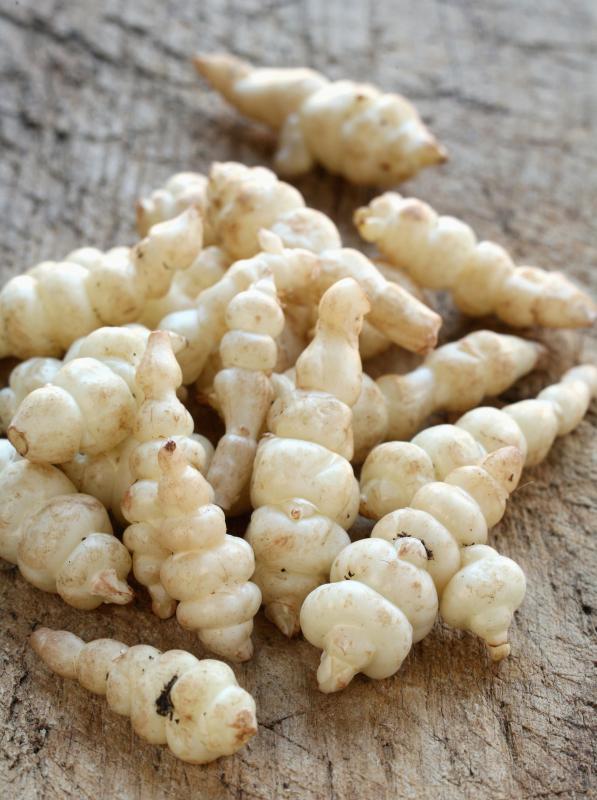At DelightedCooking, we're committed to delivering accurate, trustworthy information. Our expert-authored content is rigorously fact-checked and sourced from credible authorities. Discover how we uphold the highest standards in providing you with reliable knowledge.
What is a Crosne?
A crosne is a pale white tuber that is eaten in many parts of the world. It is native to Asia and tends to be most popular there, but it will grow well in most moderate climates. Many people compare its physical appearance to insect larvae or fat caterpillars, and it is often said to taste a lot like raw artichoke. Crosne is a versatile food that can be enjoyed in a variety of ways, though it is most commonly sauteed, fried, pickled, or steamed.
Basic Appearance

The vegetable known as “crosne” is actually the root portion of the chorogi plant, which is known scientifically as Stachys affinis. The root is typically white or ivory in color, and ranges in length anywhere from 1 to 6 inches (about 2.5 to 15 cm). The tubers are usually somewhat narrow, rarely exceeding 2 inches (about 5 cm) in width.
Each tuber is made up of between three and eight small “bulbs” or nodules linked together in a chain formation. Many people say that they resemble larvae, glowworms, or other insect life, but they can also be compared to inanimate things like beads. The unique shape is one of the first things that most cooks notice about the vegetable.
Primary Growing Region

One of the crosne’s alternative names is “Chinese artichoke,” a reference drawn in part from the vegetable’s Asian heritage. Scholars disagree to some extent when it comes to the plant’s exact biological origins, with some saying that it grew first in China and others claiming that Japan is owed that honor. The plant has grown and been harvested in both countries for centuries.
Growing these tubers is not particularly difficult, and gardeners all over the world have found success so long as temperatures are moderate and the soil is kept relatively moist. The name actually derives from the French town of Crosne, where 19th century farmers grew the crop as something of a delicacy after it was first “discovered” by local chefs traveling through Eastern Asia in the 1800s. The vegetable was quite fashionable across Europe for some time, but it is seen more commonly in Asian dishes today.
Cooking and Preparation Tips
There are many different ways to prepare this vegetable. Its peel is generally soft enough to eat, and removing it — scraping around each little nodule — is often seen as overly tedious. Some people simply eat the whole thing raw like a carrot. It can also be grated or shredded to top salads.
Chefs will often prepare cooked crosnes the same way that they would a potato. Sometimes this involves boiling, but the vegetables are commonly also sauteed, grilled, or roasted. Adding different spices and herbs strengthens their flavor and can transform them into a great side dish for many different meals. In China, the tubers are often picked and eaten either as a snack or a savory accompaniment to meats and various stir-fry dishes; in Japan, they are frequently dipped in tempura batter and deep-fried. It is also customary for Japanese families to harvest crosnes and dye them red in celebration of Osechi, an annual festival celebrating the new year.
Where to Find Them
It is not always easy to find crosnes at regular grocers or supermarkets outside of Eastern Asia. Some specialty shops and organic food markets will sell them, particularly in regions where the tubers are grown on local farms. Adventurous gardeners can often grow the plant for themselves, too, though this method often takes a lot of time and tremendous patience. It is easiest to start with an established plant, but crosnes can grow somewhat successfully from seed in most places, weather permitting. Once plants reach maturity — which often takes a year or more — the tubers are usually ready for harvesting in the mid-autumn.
Storage and Shelf Life
Once the tubers have been dug out of the earth, they must usually be eaten or cooked within a week or so. They tend to dry out pretty quickly, so storing them in a cool, moist place — in a plastic bag in the refrigerator, for instance — is usually best. A fresh crosne will be bright white and firm to the touch. If it looks limp, dull in color, or slimy, it is probably best not to eat it.
Nutritional Profile
The nutritional composition of this vegetable is very similar to most standard potatoes. It is usually classed as a carbohydrate and has a relatively high natural sugar content with relatively little protein or dietary fiber. It is good for quick bursts of energy, but it is not really considered a significant source of any nutrients.
AS FEATURED ON:
AS FEATURED ON:












Discussion Comments
@MsClean: Why are you reading about them and not about prepacked color/flavor enhanced dinners? Get a grip.
One of the easiest crosne recipes I've found is to simply saute them in some garlic butter with a little salt and pepper. With this recipe you get to fully enjoy their sweet, nutty flavor in every crunchy bite.
Another thing I like to do with crosne is to marinate them overnight with carrots rice wine, vinegar and dried dill. There delicious pickled right out of the frig, or I'll add them to some greens with sliced cherry tomatoes and scallions for a colorful crunchy salad.
To me the crosne looks more like a grub worm than a caterpillar. I've only seen them in pictures and I'm quite certain I'd never be tempted to taste one due to the fact that the appearance of them puts me off.
I suppose, however, if I could stand to handle them long enough, I could slice, dice or chop them up into small pieces, and possibly tolerate their flavor in a salad or stir-fry or something. Although it would be difficult to get the appearance of the whole vegetable out of my mind first.
They pop up in my garden all the time.
Post your comments